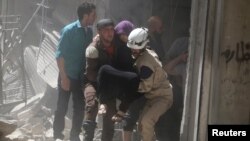U.S. and coalition airstrikes targeting Islamic State militants in Iraq and Syria killed 20 civilians and wounded another 11 during a five-month period, according to the latest assessment by military officials.
U.S. Central Command has been conducting an ongoing review of civilian casualties and said the deaths and injuries came as a result of nine airstrikes from September 2015 to February 2016.
Iraq, Syria Strikes at a glance
Iraq, Syria Strikes at a Glance:
- Sept 10, 2015: 2 killed, 4 wounded when civilian vehicle wandered into IS target area near Hit, Iraq after weapons launched
- Oct 5, 2015: 8 civilians killed in strike on IS mortar position near Atshanah, Iraq
- Nov 4, 2015: 2 civilians killed when targeted IS vehicle pulled off road, stopped near civilians in al Huwayjah, Iraq
- Nov 12, 2015: 1 civilian killed in strike on IS in Ramadi, Iraq
- Dec 10, 2015: 1 civilian killed near Raqqa, Iraq, in strike on IS external planner Siful Sujan
- Dec 12, 2015: 5 civilians killed near IS checkpoint in Ramadi, Iraq, after vehicle moved into area post-weapons launch
- Dec 24, 2015: civilian in motorcycle killed after riding into target area post-weapons launch in Tishreen, Syria
- Jan 11, 2016: 1 civilian killed, 5 injured in strike on IS cash depot in Mosul, Iraq
- Feb 2, 2016: civilian killed after driving into area where IS vehicle had been targeted, al Ghazali, Syria
In four of the nine airstrikes, officials concluded civilians were killed or injured after moving into the target area after the planes or drones had already fired their weapons.
In another strike, the U.S. concluded two civilians died after weapons had locked on and fired at an Islamic State vehicle, which then pulled off to the side of the road, stopping in an area where two civilians were present.
A statement from U.S. Central Command said the all the airstrikes complied with the law of armed conflict and all appropriate precautions were taken.”
“What you have is again, ISIL operating in crowded, populated areas,” said Central Command spokesman Col. Pat Ryder.
“Particularly with an enemy who hides among the civilian population, there are going to be, unfortunately, civilian casualties,’ he said. “We do everything we can to avoid it.”
U.S. officials have previously said they would be less averse to higher numbers of civilian casualties for some airstrikes, including those targeting Islamic State’s cash centers.
The new report found one civilian was also killed and five more injured in just such a strike on an Islamic State cash distribution center in Mosul on January 11, 2016.
“These are tough decisions the commanders have to make,” Operation Inherent Resolve spokesman Steve Warren told reporters earlier this year when asked about a separate strike on an Islamic State cash depot on January 18, 2016.
“We were prepared to accept civilian casualties, in conjunction with this cash strike,” Warren said of the January 18 strike, which was not covered in the latest civilian casualty report.
“It's tragic, and it's not something that we want to do,” he said, adding at the time that the initial estimates of civilian casualties in the January 18 strike were “extraordinarily low, single digits.”
An independent organization that monitors civilian casualties, Airwars.org, said Friday the U.S. admission of additional civilian casualties was a good step but not enough.
"We remain concerned that the Coalition is significantly under-reporting non-combatant deaths,” Airwars Director Chris Woods said in a statement published on the group’s website.
The not-for-profit group, funded by charitable organizations and human rights activists, estimates coalition airstrikes have killed between 1,064 to 1,638 civilians since August 2014 — far more than military authorities have reported.
In all, the U.S. estimates 41 civilians have been killed and 28 injured in coalition airstrikes since the start of the U.S.-led campaign against Islamic State.
In the same time, the coalition has launched 91,000 sorties (air missions) and almost 12,000 airstrikes against Islamic State targets.
“This is an extremely precise air campaign,” said U.S. Central Command’s Col. Ryder. “We take a lot of efforts to make sure we’re striking what we intend to strike.”









